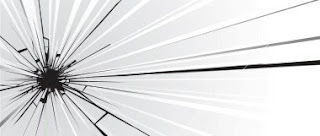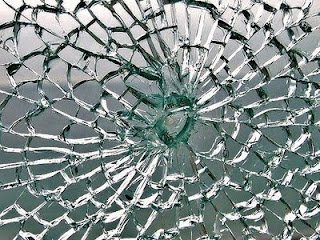>

 “Tut-tut, it looks like rain.“
“Tut-tut, it looks like rain.“Yeah, and I’m a little black rain cloud.
Clues to future climate may be found in the way glass shatters.
Results of a study published this past week in the journal Proceedings of the National Academy of Sciences find that microscopic particles of dust can break apart in patterns that are similar to the fragment patterns of broken glass and other brittle objects.
The research, by National Center for Atmospheric Research (NCAR) scientist Jasper Kok, suggests there are several times more dust particles pumped into the atmosphere than previously believed, since shattered dust appears to produce an unexpectedly high number of large fragments.The finding has implications for understanding future climate change because dust plays a significant role in controlling the amount of solar energy in the atmosphere.
Depending on their size and other characteristics, some dust particles reflect solar energy and cool the planet, while others trap energy as heat. “As small as they are, conglomerates of dust particles in soils behave the same way on impact as a glass dropped on a kitchen floor,” Kok says. “Knowing this pattern can help us put together a clearer picture of what our future climate will look like.”
The study may also improve the accuracy of weather forecasting, especially in dust-prone regions. Dust particles affect clouds and precipitation, as well as temperature. “This research provides valuable new information on the nature and distribution of dust aerosols in the atmosphere,” says Sarah Ruth, program director in the National Science Foundation (NSF)’s Division of Atmospheric and Geospace Sciences, which funds NCAR. “The results may lead to improvements in our ability to model and predict both weather and climate.”
Physicists have long known that certain brittle objects, such as glass, rocks, or even atomic nuclei, fracture in predictable patterns. The resulting fragments follow a certain range of sizes, with a predictable distribution of small, medium, and large pieces.
Scientists refer to this type of pattern as scale invariance or self-similarity. Physicists have devised mathematical formulas for the process by which cracks propagate in predictable ways as a brittle object breaks.
Kok theorized that it would be possible to use these formulas to estimate the range of dust particle sizes. By applying the formulas for fracture patterns of brittle objects to soil measurements, Kok determined the size distribution of emitted dust particles.
To his surprise, the formulas described measurements of dust particle sizes almost exactly.
“The idea that all these objects shatter in the same way is a beautiful thing, actually,” Kok says. “It’s nature’s way of creating order in chaos.”
Shattered glass = beautiful thing. Glass artists might disagree.
Click HERE to jump to complete article in the National Science Foundation News.
Other WGS : Glass Fun Facts
Glass Fun Facts: Gaffer/Composer
More Glass Fun Facts: Bullseye Glass
Historical Glass Fun Facts – How the Invention of Pyrex and The Studio Glass Movement are Connected.
